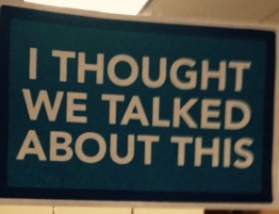The Impact of Managing Exceptions with New Rules and Policies
March 10, 2015All Great Decisions are Made on the Last Day
March 12, 2015HOW COLLABORATIVE IS YOUR ORGANIZATIONAL CULTURE?
“What you measure and reward is what you get.”
The core understanding here is that the “Continuous Improvement” initiatives of the past 40 years are different than developing “Collaborative/Innovative” organizational cultures. American business models are shifting from production values toward creation of innovative and game changing products and ideas.
-Continuous improvement cultures are production environments, where organizations are constantly trying to improve performance through incremental process improvement.
-Collaborative/Innovative cultures are created to find new and radically different ways to solve issues, and that these solutions develop a new paradigm. Collaborative/Innovative approaches are not incremental – THEY ARE GAME CHANGERS!
There are four elements to creating an organizational culture:
All stakeholders share a relentless “ALL-IN” to accomplish the organization’s mission and desired outcomes.
All organizational stakeholders are “ALL-IN” owning and adhering the organizational process and protocols.
All organizational stakeholders are “ALL-IN” understanding the individual leadership and management behaviors that are the foundation for Collaborative/Innovative cultures.
All organizational stakeholders are “ALL-IN” trusting organizational “Decision Competency”.
The 10 Cultural Practices that Will Cost You Time, Money, and Talent.
1] FOCUSING ON PEOPLE’S ATTITUDES, NOT THEIR BEHAVIORS
In most organizations, there is always someone with what others would define as a “Bad Attitude.” The person or people that have this bad attitude are always viewed as the problem and we spend time trying to find ways to improve their attitude, which we believe will improve their behaviors. I propose that defining core behaviors and focusing on positively managing those behaviors will create better attitudes. In fact, if behavioral expectations are well-understood and modeled by leadership, the team will self-manage the people with attitude problems, or the people with bad attitudes will leave on their own.
Focus on behavior expectations, not on attitudes.
READ MORE= DEFINING A BETTER WAY TO OPERATE
2] CREATING RULES AND POLICIES TO MANAGE THE EXCEPTION
Anytime you have a group of people working together, someone will do something that seems very stupid and way out of line. When this occurs, managers are confronted with a basic dilemma of how to deal with the problem. Of course, this becomes the most visible demonstration of a manager’s skill at dealing with an employee performance issue. Once the issue is resolved, the next question is how to ensure that this will never happen again. Creating a new rule or policy that you believe will ensure that this exception will never happen again sends a message to all the other team members that they are not trusted to be smart enough to know this was stupid, and now mutual trust takes a hit. Over time, if every employee bad action turns into a new rule and/or policy, the culture will spend all the time on preventing stupid behaviors vs. on valuing good behavior. Trust will fade away and compliance will deteriorate passion.
Deal with the exception but don’t make everyone pay the price for 1 stupid exception.
READ MORE= THE IMPACT OF MANAGING EXCEPTIONS WITH NEW RULES AND POLICIES
3] NOT DEALING WITH CONFLICT
Conflict is a basic human activity, an activity that very few people like to participate in. But conflict is a core activity that allows progress to be made. If an organization has no conflict – I contend that it will eventually fail. Conflict often creates tension and passion about direction and activities. Conflict can provide the energy for productive change and collaboration. Try to remember three thoughts about managing conflict: A] Make sure you are having a discussion about the same problem B] Let all of the passion be expressed before you start looking for solutions C] find a short term solution (the more the passion, the shorter the time frame).
Organizations that deal with conflicts regularly grow and change; organizations that don’t deal with conflicts stagnate and perish.
4] REWARD PROGRAMS THAT REWARD THE WRONG THINGS
Baby Boomers love competition, so most organizations being managed by Boomers have competitions – this kind of incentivizing may have worked in the past, but with 3 different generations in the current work force, it no longer motivates people to compete. The idea that competitive earned rewards will motivate people’s energy no longer works. One of my favorite questions to ask is “Are your performance measurements and performance rewards actually reflecting your effectiveness?” In most of the responses, I get the answer no. There are several things that have made rewards programs obsolete: A] The reward program was designed to increase some activity that drives top line sales or bottom line profits. Not everyone has the actual control of the factors that accomplish either of these 2 outcomes. B] The reward program has little relationship to an employee’s job description or annual review. C] When you talk about competition, there may be a winner, but everyone else is a loser.
The new world is giving rewards to people that behave and perform to the role they play in their collaborative environment, not because they beat their fellow employees.
READ MORE=DESIGNING EMPLOYEE REWARD PROGRAMS
5] THE FOCUS ON FIXING PROBLEMS NOT DRIVING STRENGTHS
Organizations / people have a pre-disposed focus on fixing an organizational problem. Everyone likes to talk about what we could do better, and in many cases, they want to talk about what “YOU” could do better. Growth is focused on what we could be doing rather than on what we Are doing. Organizational focus starts with maximizing what we are good at, and making sure that we maximize our strengths -not on achieving something new. Maximizing strengths is about “What” that is and “How” we do it. Fixing something or chasing something new is about “Why” we need to do it, and the vision of what success looks like.
Drive your strengths, before you change directions.
6] NOT FOCUSING ON HUMAN COMMUNICATIONS SKILLS
To be a great organization, you have to establish a culture that never says these words;
“I THOUGHT WE TALKED ABOUT THIS”
The best way to understand if your culture is working well is when all individuals take accountability for great interpersonal communications skills. There are 3 basic elements of this interpersonal communications effort: A] All individuals listen with he intent to understand not with waiting for a space to speak. B] It is the sender’s responsibility to send a clear message. It is the receiver’s responsibility to institute mutual understanding. When in doubt, it is the sender’s responsibility to make sure the message was understood. C] Everyone has the responsibility to make sure everyone understands what success looks like.
Great organizations know that without great individual communication behaviors you can’t be a great organization!
READ MORE=THOUGHTS ABOUT COMMUNICATION
7] NOT UNDERSTANDING GENERATIONAL DIFFERENCES IN ATTITUDES AND MOTIVATIONS
For the first time in human history, there are 3 generations working together: The Baby Boomers, The Generation Xers, and NOW here come the Millennials. Each of the three generations has different views about the world and how one should be involved in the work force. Baby Boomers are optimistic and competitive, Generation Xer’s are skeptical and very independent, and Millennials have high technical skills and a whole new way to be social. The only way to get all 3 generations engaged and on the same page is to build a collaborative organizational culture. The world is now about attracting and keeping human talent.
Without Millennials in your organization you can’t understand the largest audience in the country.
READ MORE = UNDERSTANDING GENERATIONAL DIFFERENCES
8] NOT MAKING QUALITY DECISIONS
Organizations have to make decisions, and in today’s world of Mega-Data, the preferred conversation revolves around “What does the data tell us?” Data is a start, but the reality is that decisions impact the people in the organization and without other parameters, you may make a Data-Driven decision that no-one understands or is passionate about. When making a decision, 1st decide upon the last day that the decision can be made. Remember all great decisions are made on the last day; why would you make an important decision before you have to? Make sure that you have factored the human component into any decision that will impact the organization’s people. Finally, make sure you spend time explaining: What the decision was –Why the decision was made that way –When the decision goes into effect- Who is most impacted, -and finally How the decision will be implemented.
Decisions have a huge impact on an organization’s culture; make sure they present a clear vision of what success looks like going forward.
READ MORE =THE ART OF MAKING DECISIONS
9] HAVING AN ANSWER WITHOUT A CLEAR UNDERSTANDING OF THE PROBLEM
With interactions in collaborative cultures, the effort is to let individuals “weigh in” and give opinions and thoughts about solutions before a decision is made. Allowing input without facilitation skills can create expectations that can’t be fulfilled; make sure that the problem being discussed is very clear. I love to sit in brain storming meetings and listen to people throw out solutions to what they perceive as the problem – in most cases, individuals are giving solutions to a bunch of different problems. Always be sure to write out the problem and ensure that everyone is clear as to what the problem is. Many times, the initial problem was caused by a solution to an earlier problem, so always ask the 2nd question—“Why is this a problem?”.
Never decide a solution before you clearly define the problem, and always ask “Why is this a Problem?”
READ MORE=UNDERSTANDING THE PROBLEM BEFORE YOU DECIDE ON A SOLUTION
10] NOT HIRING THE RIGHT PEOPLE
Hiring the right people will always be better than dealing with poor performing employees later. Hiring the right people, will always help create a better culture than hiring someone that does not fit in. There are lots of thoughts about how to do this – but here are a few suggestions that I believe might help: A) Hire for the talents and personality of the individual, not the work experience. Just because they have done it before does not mean they will fit to your culture. B) Find out if they are very curious – Curious people will fuel passion and not be afraid of change. C) Figure out if they are empathic – to be collaborative, people need to be able to understand others’ needs and issues. D) Look to see if they are fun to play with. Collaboration needs to be fun.
Personality-Talents-Curiosity-Empathic Skills–and Fun –
People, with these traits will figure out how to play in collaborative sand-box- and innovation and adaptation will be the outcome.
READ MORE=HIRING THE RIGHT PEOPLE
PLEASE TAKE A MOMENT TO FILL OUT THIS QUICK 4 QUESTION SURVEY. THANK YOU FOR HELPING US BUILD COLLABORATIVE WORK CULTURES!





